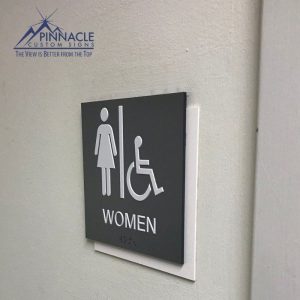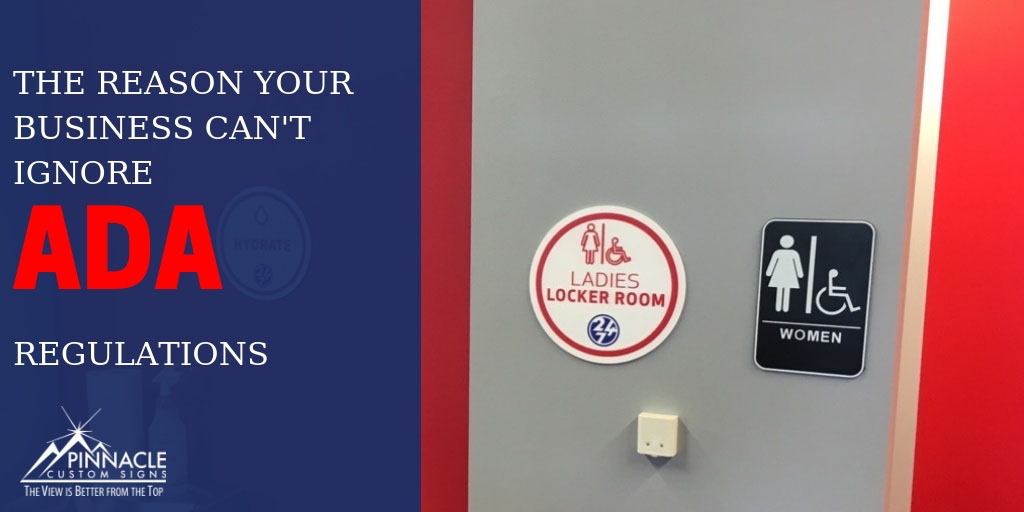As the owner of a company, you need to take a few minutes to learn the reasoning and requirements of the Americans with Disabilities Act (ADA). Understanding ADA signs helps your business to meet the rules and avoid costly fines or possible lawsuits for non-compliance.
Americans with Disabilities Act (ADA)
The ADA act prohibits discrimination and guarantees that people with disabilities have the same opportunities as everyone else to participate in the mainstream of American life — to enjoy employment opportunities, to purchase goods and services.
 So, what does that have to do with signs? The ADA also regulates signs to ensure that Americans with disabilities can access and navigate in public buildings. It covers things like readability for both those who can see and not see. For instance, ADA signage rules require that characters have high contrast, tactile letters and braille.
So, what does that have to do with signs? The ADA also regulates signs to ensure that Americans with disabilities can access and navigate in public buildings. It covers things like readability for both those who can see and not see. For instance, ADA signage rules require that characters have high contrast, tactile letters and braille.
How that affects our clients
Although there are some exceptions, almost all storefronts, offices, restaurants, retail spaces and entertainment venues, as well as public buildings and spaces must follow ADA signs. So, ask yourself — Does my business work with the public and Is my business ADA compliant?
Take a closer look at ADA’s business regulations:
Signage placement: ADA rules for companies also cover where to mount your signs. An example? For rooms with a door, the ADA sign should be on the side of the latch. Another example? On double doors, the ADA space identification plate must be on the right of the right door.
Mounting Heights: Following the mounting rules is one of your last considerations to ensure ADA compliance. Catalog boards should be mounted at least 27 inches from the floor, but not more than 80 inches at the top. Overhead signs must have an 80-inch clearance from the underside of the sign to the floor. Of course, standards may change depending on the application.
 Contrast and signs: Per ADA signage rules, high contrast is a must between background and character colors. Your ADA-compatible characters should have dark characters on a bright background or light on a dark background.
Contrast and signs: Per ADA signage rules, high contrast is a must between background and character colors. Your ADA-compatible characters should have dark characters on a bright background or light on a dark background.
ADA signature typing styles: All character characters must be displayed in a simple, serial typestyle to be ADA code compatible.
Braille and tactile signs: On space signs, ADA guidelines require that signs increase by 1/32 inch (0.8 mm). Characters should also have Grade II Braille that is rounded. Flat and square corners are not allowed. In case of overhead or directed ADA signage, no text and braille are required.
Character and height: For signs of permanent spaces, ADA requirements indicate that characters must all be large and follow a strict height / width ratio. For upper and lower brackets as well as benchmarks, letters can be used in upper- and lower-case letters. On overhead and flag mountings, two inches are the smallest font size. With directional signage, the character height must be scaled to the distance.
 Pictogram usage: Pictograms are international symbols required for ADA phone, toilet and non-smoking characters. They should also have a written description under the symbol. According to the ADA guidelines, office signs and room numbers do not require pictograms
Pictogram usage: Pictograms are international symbols required for ADA phone, toilet and non-smoking characters. They should also have a written description under the symbol. According to the ADA guidelines, office signs and room numbers do not require pictograms
Handicapped Parking: The Americans with Disabilities Act requires that most public buildings offer ample accessibility for disabled people. ADA signs marking designated parking spaces should contain the well-known international accessibility symbol. It shows a person who uses a wheelchair over a blue background.
Seek a Second Set of Eyes
Asking yourself if your business is compliant may be overwhelming. The ADA law covers a lot of aspects of business operations, but Pinnacle Custom Signs is here to help you with access and visibility needs for ADA signs. We provide complementary consultations and professional feedback to ensure that your business is operating within the rules of governance for a public space. We can provide multiple options for your signs and ADA-compliant characters for all budgets. Give us a call to get started.







